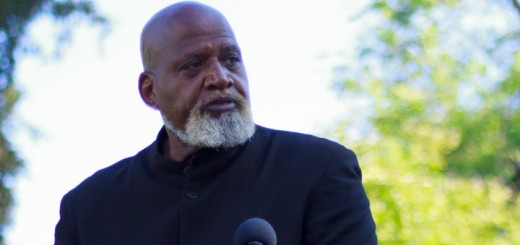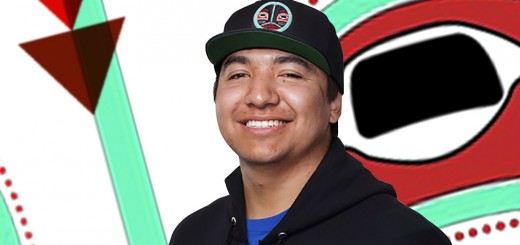The Grit Squad

The team practices and competes elsewhere, but Marissa Buckley, Rebecca Garcia, Karina Nunes and Madiha Raza wanted to run down memory lane at the former “Speed City” track.
Madiha Raza had finally made her excruciating decision. After much deliberation, the 2013 Evergreen-San Jose High School graduate decided to give up her athletic dreams as a track and field sprinter to focus strictly on her education.
“It was either attend De Anza College and run track or go to San Jose State and dive into my degree,” she says. “It was hard. I still wanted to run. But I gave it up.”
Not for long.
Two months into her freshman year, Raza learned SJSU had added women’s outdoor track and field to its list of 11 other Division I intercollegiate female athletics programs, its first addition of any sport for either men or women since 1997. The new track and field program also marked the rebirth of a sport that helped put SJSU on the athletic map and earned the tag “Speed City” in the late 1960s, when Lee Evans, John Carlos, Ronnie Ray Smith and Tommie Smith combined for four gold medals and a bronze at the 1968 Mexico City Summer Olympics.
Raza, 19, knew about the school’s rich track and field history—“everyone knows about Speed City and Mexico City whether you’re a track fan or San Jose State student or not,” she says. But when she heard there’d be tryouts for the school’s new spring sport, her thoughts were on the future, not the past—specifically, her future. “I was so excited,” she says. “I felt I had a chance to do everything I wanted—like I had a new life, a new opportunity.”
New program, new coaches

Student-athletes with the first-ever SJSU women’s track coaching staff: Jeff Petersmeyer, Kelley Watson, Brad Wick and Matt Layten.
Three of the coaches who helped turn Boise State’s struggling track and field program into a West region juggernaut are now at SJSU, heading the women’s track and field program. Head coach Jeff Petersmeyer is in charge of jumps and heptathlon; assistant Kelley Watson is responsible for sprints, hurdles and relay; and Brad Wick oversees the squad’s distance runners.
An Ohio native, Petersmeyer was an All-American quarter-miler at Division III power Baldwin Wallace (Berea, Ohio). He served 17 years as an assistant all over the map— Columbia, Northern Arizona, Texas Christian University (TCU)—before landing in Boise from 2010-2013, where he became interim head coach. During his last two months on the job, the Boise Broncos secured eight individual titles at the 2013 Mountain West Championships, including a sweep of the women’s long distance events, headed by Wick.
During his career, Petersmeyer has coached 17 conference champions and three All-Americans, including NCAA women’s outdoor long jump record holder Whitney Gipson at TCU and NCAA decathlon champion Kurt Felix, whom he coached at the 2012 London Olympics. Coaching at the Olympics was an “awesome” experience, Petersmeyer said, but he’s equally psyched about coaching at SJSU. “Gene (SJSU Athletic Director Gene Bleymaier) told me I would love it here, and he was right.”
After signing on, Petersmeyer’s first order of business was to hire Watson and Wick, his coaching comrades at Boise State. He already knew the trio worked well together, could debate honestly and, most importantly in this case, could hit the ground running. SJSU’s program had to be built from the ground up—without the use of a home track.
Securing Wick was key because the brunt of the initial track and field team would be filled by cross-country runners, such as SJSU junior Rebecca Garcia.
Wick coached 11 first-team all-conference runners and four All-Americans in his five seasons as men’s and women’s cross-country coach at Boise State and led the Broncos to their first conference title in 2010.
Hiring Watson was also “crucial for us,” Petersmeyer says. “Kelley’s from the Bay Area, and her ability to recruit is vital.”
A former Central Coast Section hurdles champion at Milpitas High School, Watson forged a college track career at Cal State Northridge. After graduation, she made the fast track from high school assistant in two of the toughest inner city regions in the country—North Miami (Dade County, Fla.) and Castlemont (Oakland, Calif.)—to Boise State, where she helped athletes garner 10 school records, headed recruiting efforts and served as the director of operations.
When Petersmeyer called to gauge her interest in an assistant position, her response was: “consider it done.” To be part of the new program and rejoin her Boise colleagues at SJSU, Watson turned down a dozen other coaching offers.
When we get this program up and going, the nation is going to stop and take notice,”
she says. “A chance to bring back Speed City doesn’t happen very often. And I get to do that with my two best friends … in my hometown … in the Bay Area. I love this place!”
Woman athletes with grit
At 5-foot-2 and barely 100 pounds, Raza isn’t a prototypical sprinter. Her high school marks weren’t terribly impressive either and a stress fracture in her left leg cut back her senior season.
But Watson wasn’t expecting world-beaters in the team’s first spring season. To complement the distance crew, the coaches sought a few hungry sprinters, such as Raza and Taylor Griffin, another 100- and 200-meter specialist who hailed from Santa Teresa High School.
Griffin originally had her sights set on Boise State. “Once I heard San Jose State was adding women’s track, I switched everything,” she says. “It’s so exciting to go down in history as the first women’s team. I can tell my children and neighbors and friends that I was part of history.”
Even so, in the short term, Watson realized that a willingness to train on high school tracks, to work extremely hard without the reward of immediate success, required a special kind of athlete. So, this spring, Watson went looking for “some gritty young ladies.” In Raza, the coach seems to have found a poster child for the grit squad.
“She’s quiet, but when it comes time for workout, she throws it down,” Watson says.
She has a lot of mental toughness. She gets through it. She has a beautiful stride.”
Juggling classes and track practice leaves little time for play or socializing. But Raza knew that, coming in.
“Oh, I love it,” she says. “Our team is small but we’ve grown close. I’m a structured person anyway, so practices force me to get more done academically. My high school GPA has actually improved since I’ve been in SJSU’s track program.”
2015 and beyond
Petersmeyer has already signed two of the nation’s top 20 prep horizontal jumpers— Kelsey Johnson-Upshaw and Nicole Iloanya—along with sprinter DeAndrea Powell for the 2015 season. Add a top California hurdler (Makayla Webb), elite Florida sprinter (Caitlin Wilson) and versatile Idaho sprinter and jumper Cambree Harbaugh, and Petersmeyer already considers this a better recruiting class than he ever had at Boise.
“It’s really been about recruiting this year and shaping the culture of the program with the student-athletes we do have,” he says.
Wick agrees. “The first step was changing the culture,” he says, “and we’ve definitely started to do that.”
The student-athletes have also seen a difference.
“It’s an entirely different program,” cross-country specialist Garcia says. “The coaches have laid down a clear and strong foundation. They care about how much we run. They track our exact mileage and eating habits. It feels like we’re in a legitimate Division I program now.”
“Every program has a niche and our vision is to attack at the horizontal jumps, sprints and distances,” Petersmeyer says. “We’re making decisions now that will affect the program three to five years down the road.” By 2017, he hopes there will be a new facility and a track for his team.
With a limited number of scholarships available, Petersmeyer doesn’t expect to put together a 100-person squad, but he is “open” to adding 15 to 20 “good strong female student-athletes” to the current 20-member team.
As a “young coach, if an athlete said they wanted to go to the Olympics, I was skeptical,” he admits. “Now I’m good with it. I want that attitude. I want young women to have grit and aspirations to be the best they can be.”
“The Speed City history is awesome here, it really is,” Wick says. “At the same time, we don’t want to be stuck in that. It’s a different time and era. Realistically, we’re never going to be the number one program in the country. But we can be a conference champion and one of the top 10 programs in the West. It will take time, but not a decade. We got better this season and will get significantly better next year and more significantly better the year after that.”
“Ten years from now,” Watson adds, “when this team of women returns for an alumnae dinner, they can tell everyone: ‘We started all this.’”
Help the team and coaching staff burst out of the starting block!




I enjoyed this article! I’m glad to see that SJSU supports a diversity of students. Having “grit” is the most important skill an athlete could have. Even if someone isn’t a “prototypical” star, they still deserve a chance to prove themselves. I wish more schools would support this kind of talent, rather than only scouting “stars” who peak too soon and burn out quickly. Kudos to the coaches for building a great program. Keep up the good work, SJSU! Go Spartans!